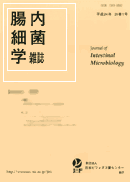All issues

Volume 26 (2012)
- Issue 4 Pages 211-
- Issue 3 Pages 159-
- Issue 1 Pages 3-
Predecessor
Volume 26, Issue 1
Displaying 1-2 of 2 articles from this issue
- |<
- <
- 1
- >
- >|
-
Yoshitaka Nakamura2012 Volume 26 Issue 1 Pages 3-9
Published: 2012
Released on J-STAGE: February 21, 2012
JOURNAL FREE ACCESSThe polymeric immunoglobulin receptor (pIgR) is an integral membrane protein expressed by intestinal epithelial cells. The physiological role of pIgR is to bind and transport dimeric IgA (dIgA) antibodies across the intestinal epithelial cell layer. The secretion of dIgA into the intestinal lumen depends on 2 factors: (1) the production of dIgA by mucosal plasma cells and (2) the transport of dIgA across the epithelium mediated by pIgR. A considerable amount of research focusing on the effect of prebiotics and probiotics on the expression of dIgA has been conducted. However, it has not yet been determined whether prebiotics and/or probiotics influence the expression of intestinal pIgR; thus, we undertook the investigation described herein.
View full abstractDownload PDF (451K) -
Koji Hase2012 Volume 26 Issue 1 Pages 11-17
Published: 2012
Released on J-STAGE: February 21, 2012
JOURNAL FREE ACCESSVigorous macromolecular transcytosis via M cells delivers mucosal antigens to the underlying organized lymphoid follicles and is believed to be a prerequisite for initiating antigen-specific mucosal immune responses. However, the molecular mechanisms promoting this antigen uptake are largely unknown. We recently found that glycoprotein 2 (GP2), specifically expressed on the apical surface of M cells, serves as a transcytotic receptor for Escherichia coli and Salmonella spp. by recognizing FimH-expressing type 1 pili. GP2-/- mice were defective in transcytosis of FimH+ bacteria and showed impaired antigen-specific mucosal immune responses to these bacteria. These data demonstrate that recognition of FimH by GP2 is essential for the uptake of type-1-piliated bacteria into M cells, leading to an antigen-specific mucosal immune response. Thus, GP2 plays a vital role in M-cell-mediated mucosal immunosurveillance for type-1-piliated bacteria. We also found that a cytosolic protein named M-Sec is localized on tunneling nanotube (TNT)-like structures interconnecting Peyer’s patch M cells. M-Sec functions as a key regulator of TNT formation through interaction with the Ral-exocyst pathway. Collectively, these data shine a light on the molecular machinery by which M cells facilitate antigen transcytosis.View full abstractDownload PDF (943K)
- |<
- <
- 1
- >
- >|